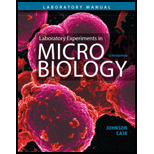
What are the Gram reactions of Clostridium and Bacillus?
What genus has swollen endospores?
To determine:
The gram reactions of Clostridium and Bacillus.
The genus with swollen endospores.
Introduction:
Gram stain is a staining method that helps in the differentiation of gram-negative bacteria and gram-positive bacteria, by determining the physical and chemical properties of their cell wall. Crystal violet stain is used in this test. Gram positive bacteria has a high affinity for crystal violet when gram's iodine is applied to it. in this test, the decolorizing agent used is acetone or ethyl alcohol. Acetone gets dissolved in the lipids of the cell wall of the gram-negative bacteria, which leads to the leaking out of the crystal-violet complex from the thinner peptidoglycan layer.
Explanation of Solution
When the bacterial cells are in a dormant state, then they form endospores. In dormancy, cells do not undergo metabolism and are said to be in the resting phase. Endospores are formed by bacteria, when they face changed or harsh environment, like, less availability of water, nutrients, and growth temperature.
Clostridium is a gram-positive bacterium and causes botulism in humans. It is an anaerobic bacterium with two forms, endospore form and vegetative form. Clostridium microbe is at rest until it is in a stable and improved environment. Generally, in harsh climates, clostridium survives due to the presence of endospores.
Bacillus is a gram-positive bacterium that is rod-shaped. Generally, bacillus is not harmful to humans. But the most common disease caused by bacillus to humans is anthrax. Moreover, bacillus contains swollen endospores as compared to clostridium.
The gram reactions of Clostridium and Bacillus are gram-positive.
The genus with swollen endospores is bacillus.
Want to see more full solutions like this?
Chapter 9 Solutions
Laboratory Experiments in Microbiology (12th Edition) (What's New in Microbiology)
- You intend to insert patched dominant negative DNA into the left half of the neural tube of a chick. 1) Which side of the neural tube would you put the positive electrode to ensure that the DNA ends up on the left side? 2) What would be the internal (within the embryo) control for this experiment? 3) How can you be sure that the electroporation method itself is not impacting the embryo? 4) What would you do to ensure that the electroporation is working? How can you tell?arrow_forwardDescribe a method to document the diffusion path and gradient of Sonic Hedgehog through the chicken embryo. If modifying the protein, what is one thing you have to consider in regards to maintaining the protein’s function?arrow_forwardThe following table is from Kumar et. al. Highly Selective Dopamine D3 Receptor (DR) Antagonists and Partial Agonists Based on Eticlopride and the D3R Crystal Structure: New Leads for Opioid Dependence Treatment. J. Med Chem 2016.arrow_forward
- The following figure is from Caterina et al. The capsaicin receptor: a heat activated ion channel in the pain pathway. Nature, 1997. Black boxes indicate capsaicin, white circles indicate resinferatoxin. You are a chef in a fancy new science-themed restaurant. You have a recipe that calls for 1 teaspoon of resinferatoxin, but you feel uncomfortable serving foods with "toxins" in them. How much capsaicin could you substitute instead?arrow_forwardWhat protein is necessary for packaging acetylcholine into synaptic vesicles?arrow_forward1. Match each vocabulary term to its best descriptor A. affinity B. efficacy C. inert D. mimic E. how drugs move through body F. how drugs bind Kd Bmax Agonist Antagonist Pharmacokinetics Pharmacodynamicsarrow_forward
- 50 mg dose of a drug is given orally to a patient. The bioavailability of the drug is 0.2. What is the volume of distribution of the drug if the plasma concentration is 1 mg/L? Be sure to provide units.arrow_forwardDetermine Kd and Bmax from the following Scatchard plot. Make sure to include units.arrow_forwardChoose a catecholamine neurotransmitter and describe/draw the components of the synapse important for its signaling including synthesis, packaging into vesicles, receptors, transporters/degradative enzymes. Describe 2 drugs that can act on this system.arrow_forward
- The following figure is from Caterina et al. The capsaicin receptor: a heat activated ion channel in the pain pathway. Nature, 1997. Black boxes indicate capsaicin, white circles indicate resinferatoxin. a) Which has a higher potency? b) Which is has a higher efficacy? c) What is the approximate Kd of capsaicin in uM? (you can round to the nearest power of 10)arrow_forwardWhat is the rate-limiting-step for serotonin synthesis?arrow_forwardWhat enzyme is necessary for synthesis of all of the monoamines?arrow_forward
- Basic Clinical Lab Competencies for Respiratory C...NursingISBN:9781285244662Author:WhitePublisher:Cengage
 Concepts of BiologyBiologyISBN:9781938168116Author:Samantha Fowler, Rebecca Roush, James WisePublisher:OpenStax College
Concepts of BiologyBiologyISBN:9781938168116Author:Samantha Fowler, Rebecca Roush, James WisePublisher:OpenStax College Biology Today and Tomorrow without Physiology (Mi...BiologyISBN:9781305117396Author:Cecie Starr, Christine Evers, Lisa StarrPublisher:Cengage Learning
Biology Today and Tomorrow without Physiology (Mi...BiologyISBN:9781305117396Author:Cecie Starr, Christine Evers, Lisa StarrPublisher:Cengage Learning Principles Of Radiographic Imaging: An Art And A ...Health & NutritionISBN:9781337711067Author:Richard R. Carlton, Arlene M. Adler, Vesna BalacPublisher:Cengage Learning
Principles Of Radiographic Imaging: An Art And A ...Health & NutritionISBN:9781337711067Author:Richard R. Carlton, Arlene M. Adler, Vesna BalacPublisher:Cengage Learning





